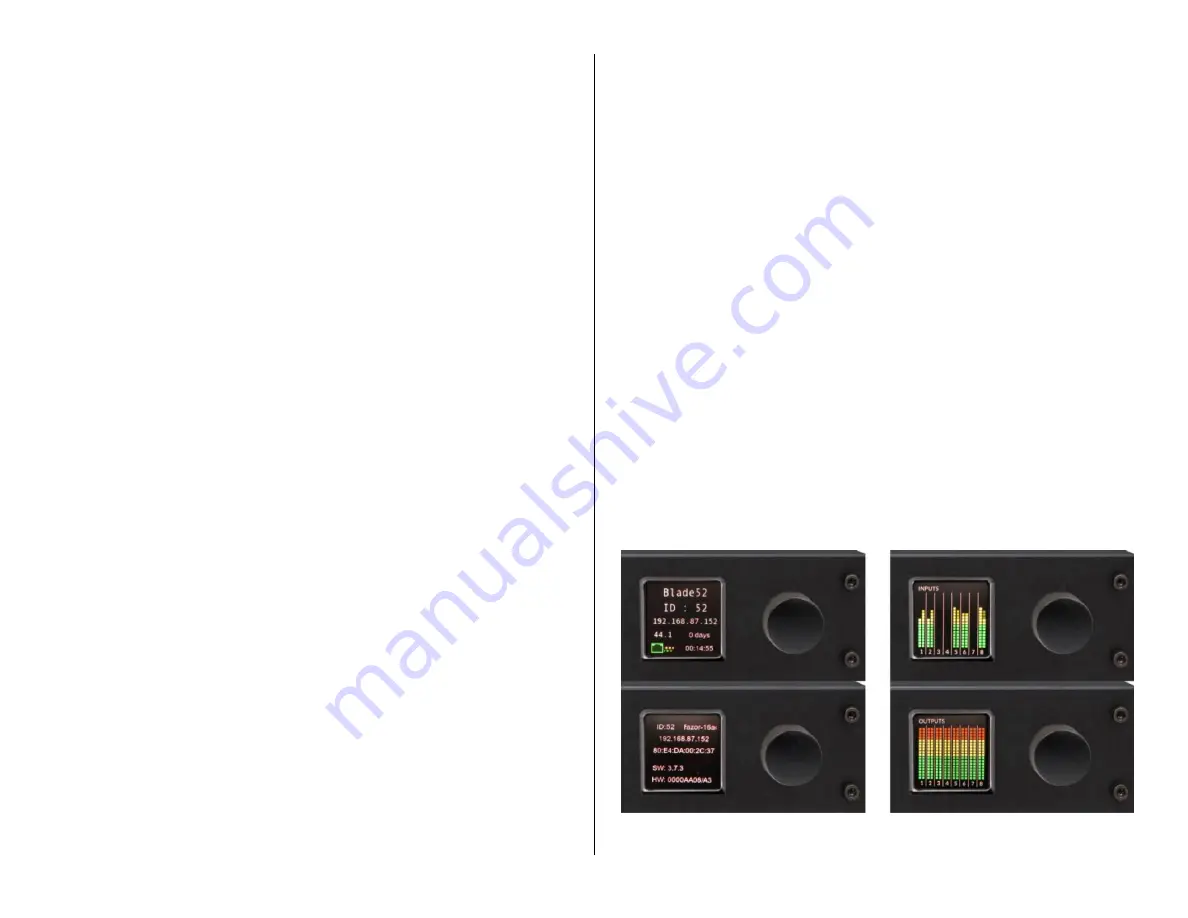
58
the caller on the other channel. The easiest method to do this is to
dedicate PGM 3 for call recording.
To use the “PGM 3 method” you’ll want
the host mic on a second fader
channel, so the original channel is still available to feed air. Typically, the
mic is also assigned to channel 7 (or 15) and the phone is assigned to
channel 8 (or 16). Assign the mic and phone channels only to PGM 3
—
making sure no other channels are assigned to PGM 3. Use
Navigator
to
connect PGM 3 to the call recorder output. Use the Advanced Channel
Feature
Pan
to pan the mic channel fully to the left channel and pan the
phone channel fully to the right channel. The caller audio is now separated
from the talent audio and each channel of the recording can be individually
edited on the call recorder.
The advantage o
f using the “PGM 3
method
” is that it
allows the call
recorder to connect via Ethernet, using WNIP drivers, or by using any
stereo analog or digital output. It also means the call recorder can easily
be set to record stereo programming. These
“Telco Record”
channel
sources and pan settings can be saved as an Event to quickly reset the
console for call recording by recalling that Event.
If you don’t have a spare channel for a second mic, and are using an
analog phone hybrid, then you could use two Y cables, one on the phone
hybrid and the other on the console output that connects to the phone
hybrid. One channel will be the caller audio while the other will be the mix-
minus going back to the caller (e.g., the talent mic audio). If the call
recorder
’s
analog input is not balanced, a balanced-to-unbalanced balun,
or a matchbox, will need to be used.
Going Live-to-Air
When a caller or remote will go live-to-air, their
PGM 1
and
Cue
buttons
should be assigned. When their channel is off the caller/remote will hear
the Off Line bus (any channel assigned to PGM4/OL minus their own
channel). Typically, only the board operator mic is assigned to PGM 4/OL,
but you may need a producer mic assigned as well. This allows the board
operator (and producer) to talk with the caller/remote to prepare them for
going live-to-air.
When the caller/remote channel is turned on, their mix-minus audio
switches so they hear everything assigned to PGM 1 (minus their own
audio) so they can interact accordingly. If the board operator needs to talk
to the caller/remote while they
’
re on-air, they press the momentary
TB
button on the caller/remote channel to give them cues (a break is coming
up, etc.). This action interrupts the return audio so using TB while live
should be used sparingly, and certainly not while the caller or remote is
talking.
RAZOR I/O INTERFACE
Razor I/O Interfaces are 1RU rack mount devices installed in the studio
and/or TOC (Technical Operations Center) to connect additional peripheral
equipment with the DMX console and other devices on the WNIP network.
Each Razor has eight stereo/16 mono inputs and eight stereo/16 mono
outputs. A Razor is often used to interconnect satellite receivers, tuners,
phone hybrids, codecs, internet streamers, air chain processor, and
recorders with the DMX console.
Their input signals often appear as sources on DMX fader channels while
their outputs may be connected to console PGM buses or to channel bus-
minus signals. If you
’
re checking for levels, engineering should have
supplied a list of the input and output signals on each Razor so you can
confirm whether a specific signal is present since that is the biggest use
for the Razor front panel display by a board operator.
The Razor’s front panel has the same
type OLED display and large knob
rotary encoder as used on the DMX fader channels. Rotate the encoder to
switch the display between four screens: Input Levels, Output Levels, and
two screens displaying technical details on that Razor (name, ID#, IP
address, sample rate, MAC address, software revision, and hardware
revision). The four screens are shown in Figure 4-16.
The two screens of interest to board operators are the Inputs and
Outputs screens. Unlike the DMX console meters these displays only show
average levels using vertical bar graphs since they are mainly to confirm
there is a signal present and its level appears
“
normal.
”
The Inputs display, in Figure 4-16, shows normal signal levels where all
the green and a few yellow segments are lit up. Three inputs (3, 4, and 7)
have no audio. The Outputs display shows a test tone, set for the
maximum signal level, being fed to all eight stereo outputs which lights up
all meter segments. In practice, both Inputs and Outputs levels would
appear like the levels shown in the Inputs display.
Figure 4-16 Razor Front Panel Displays
Содержание AUDIOARTS ENGINEERING DMX Series
Страница 1: ...1 Networked AoIP Broadcast Console Manufactured by Wheatstone Corporation ...
Страница 4: ...4 ...






































